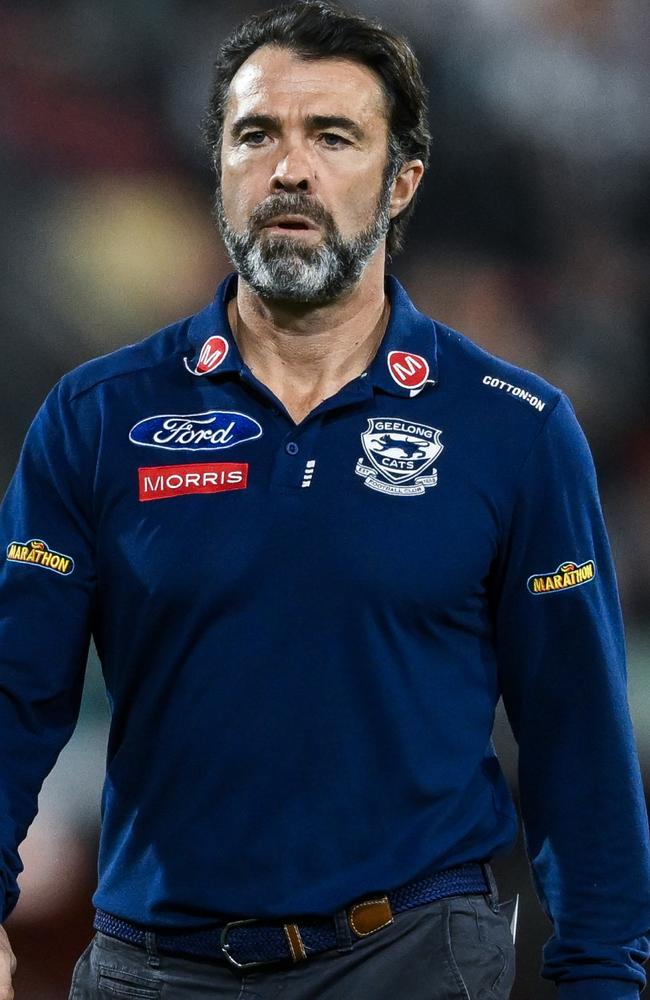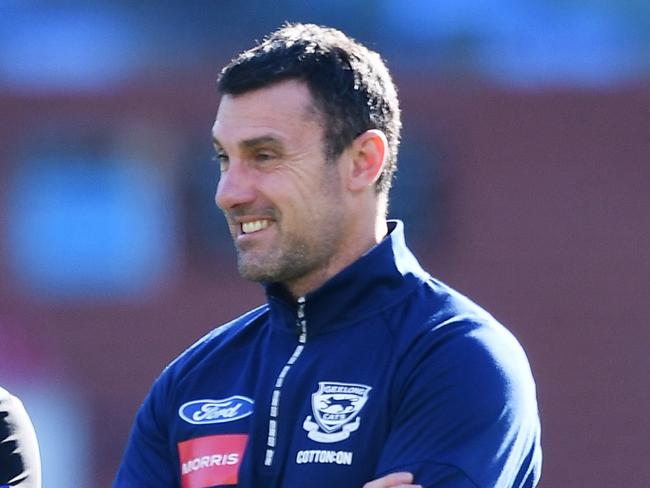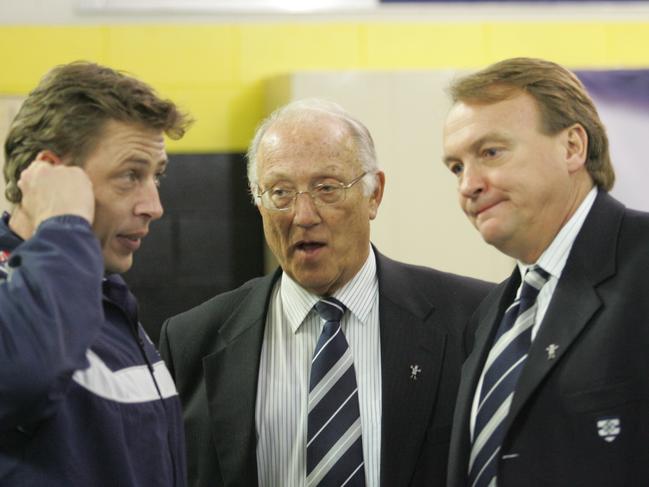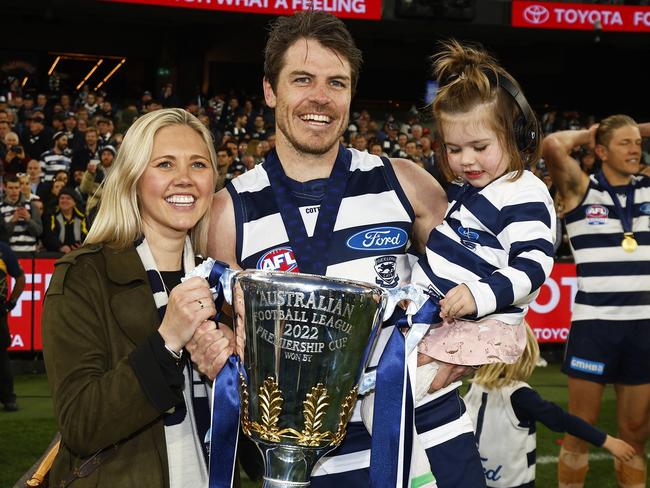Coaching? Lifestyle? The ingredients behind Geelong’s sustained excellence
For almost 20 years, the Cats have been a beacon of excellence for the rest of the AFL to marvel at. But how do they do it? Scott Gullan investigates how they stay in the premiership hunt.
Geelong
Don't miss out on the headlines from Geelong. Followed categories will be added to My News.
Geelong has been cooking-up greatness for almost two decades, much to the chagrin of rivals who have spent endless hours trying to figure out the magic ingredients behind the Cats’ dynasty. There are many secret herbs and spices that go together under the guidance of head chef Chris Scott to have the blue and white hoops brigade again within reach of another Grand Final appearance.
GEELONG’S RECIPE FOR SUCCESS
COACHING
It is a famous quote which those inside Geelong have heard more than once: “We’re in it to win every year, f--- everyone else.”
That has been Chris Scott’s philosophy from the moment he walked into Kardinia Park, winning a premiership in his first year in 2011.
While many commentators have predicted the Cats to fall off the cliff, the coach hasn’t wavered.
“Don’t undersell that in terms of the group knowing every year that you play, they are all-in to win every year,” one Cats insider said. “How many times in the past decade has the narrative been that Geelong is going to go down.
“He just says we don’t think we are so we don’t.”

Two-time premiership defender Harry Taylor, who also returned to the club to work in the high performance department during the 2022 premiership, says the mantra resonates with the players.
“We never hear rebuild, you never hear that sort of language, it just hasn’t existed for a long period of time,” Taylor says. “There is a bit of tinkering and stuff done around the edges but fundamentally the team exists to win premierships and compete every single year.
“That’s how the program has been set up and you hear that message as a first-year draftee all the way to an 18-year veteran like Hawk (Tom Hawkins).”
Scott’s record is extraordinary. He is Geelong’s longest-serving coach – Saturday’s preliminary final will be his 334th in charge – has won two premierships and been in the finals 11 times in his 14 seasons.
He has the best winning percentage of all coaches, at an incredible 67.9 per cent.
“His ability to make the complex simple I think is his most outstanding trait,” Taylor says. “He spends a lot of time trying to get himself in the best position to coach really well and that shouldn’t be understated.
“We ask our playing group to prepare as well as possible, to go out and perform, it’s probably no different for our coaches and other staff.
“Geelong’s program allows him as well as anyone else to put themselves in the best spot to do that.”
Having former premiership heroes who have the Geelong DNA in their veins around the place is also a key factor. The current coaching panel includes Steven King, James Kelly and another former player James Rahilly. Two-time premiership goal sneak Shannon Byrnes is the runner and part of the development team while Andrew Mackie is the football boss.
Other former greats such as Matthew Scarlett, Corey Enright and Max Rooke have previously been a part of Scott’s panel.
RECRUITING
Since the drought-breaking premiership in 2007 there has been talk about getting a statue of recruiter Stephen Wells outside the front of GMHBA Stadium.
He has been in the gig more than 30 years with a record the envy of every other club.
What sets him apart is the ability to create a list without having access to high-end draft picks with this current team a perfect example.
If key defender Sam De Koning gets picked to play against Brisbane he will be the highest draft pick – No. 19 in 2019 – the Cats have used to create this team.
Nine players in this team the Cats have got directly out of the national draft with their selections, ranging from No. 19 to No. 63 while seven have graduated from the club’s rookie list.
“I think Geelong in particular, through picks 40 to 60, or the third, fourth round and rookies, it feels like they have been able to maximise those picks as well as anyone in the competition,” Taylor said.
“It complements why Geelong wants to compete every year, if you want to do that the shadow side of that is you’re likely not to have high picks as you obviously finish high up the ladder.
“Geelong embraces that, they realise we’re not going to get picks 1 to 10 that often so we need to maximise those picks at the back end of the draft.
“That’s why they concentrate and put a lot of time and effort into doing that.”
But it has been Wells’ ability to land the big fish which has gone a long way to keeping the dynasty going.
This team wouldn’t be still winning, or contending, for premierships if Patrick Dangerfield and Jeremy Cameron hadn’t been lured to the Cattery.
Executing the trade to have Dangerfield returning home from Adelaide at the end of 2015 was a pivotal moment, putting the brakes on a potential slide.
In 2013 the Cats were the best team in it but came up short in the preliminary final against Hawthorn, blowing a golden opportunity. The following year they exited the finals in straight sets and then missed the finals for the first time under Scott in 2015.
There were murmurings. Captain Joel Selwood was carrying the load and getting more and more frustrated.
“If you look at that trend, it wasn’t trending positively and then getting Dangerfield in changed everything,” one former Cat said. “When Pat came in Joel was rapt and when Jezza (Cameron) came in Tom (Hawkins) was rapt, it wasn’t like these guys are coming in on my patch.”
Dangerfield won the Brownlow Medal in his first year at Geelong and has won three best and fairests while Cameron’s move from the GWS Giants at the end of 2020 resulted in a premiership two years later.
DEVELOPMENT
Former West Coast premiership coach Adam Simpson was recently asked about why Scott and Geelong had managed to stay at the top.
He declared the Cats do the “fundamentals” better than anyone else.
The development program has long been hailed as one of the Cats secret weapons.
Talk to any of the premiership stars from the 2007-09-11 era and they’ll speak about spending endless hours kicking the ball with assistant coach Brendan McCartney who, along with senior coach Mark Thompson, preached contested football.
Former Brisbane star Nigel Lappin joined the Cats coaching staff two weeks after he retired in 2008 and has been there ever since. He has floated in between being an assistant coach and running the development program.
Whatever his title, Lappin’s fingerprints are all over this current team. He puts time into people and the mail is he’s “very, very bullish” about the next crop of youngsters to come through.

The success of the rookie list is what rivals point at when they are quizzed about Geelong’s development program.
At the top is Mark Blicavs, a two-time best and fairest winner, who was a steeplechaser when he arrived and had barely touched a Sherrin for years. Others like Tom Atkins were doing the hard yards in the VFL team before being remodelled into a premiership midfielder.
The current development team includes VFL coach Mark Corrigan, premiership rover Shannon Byrnes, ex-Bulldog Brett Goodes, the brother of Sydney champion Adam, and Mark Worthington.
Former Magpie Shane O’Bree, who is now in the Cats recruiting department, has also been a key player over the years in development.
STABILITY/CULTURE
This is Geelong’s one-wood.
Having the same people in key positions for a significant length of time who set the cultural agenda is the stuff most other AFL clubs have only been able to dream about.
This century Geelong has only had two coaches, two chief executives and three presidents.
The famous triumvirate of Frank Costa, Brian Cook and Mark Thompson set up the drought-breaking 2007 premiership. Scott then replaced Thompson in 2011.
Cook remained as CEO until moving to Carlton in 2022 with his replacement Thompson’s former right-hand man, ex-Cat Steve Hocking, who’d moved to the AFL to be the league’s football boss.
Costa retired in 2010 and handed the reins over to former AFL Commissioner Colin Carter who steered the ship for the next decade. Craig Drummond is currently in his fourth year as president.
“Stability in key roles for a long time helps enormously,” Taylor says. “By stability I mean also a willingness to adapt, shift and move with the times.

“This is what I believe Geelong has done particularly well, they have been able to reinvent, realign despite quite a bit of turnover from a playing group and staff perspective.”
Culture is a buzz word – thanks to Melbourne CEO Gary Pert’s infamous quote last year – and the foundations of what Geelong is today was set back in the summer of 2006-07.
That’s when Thompson instigated some confronting honesty sessions among the playing group which changed the trajectory of the club forever.
“We rode on the coat-tails of some of the great work the club did around 2006-07,” Taylor says. “That’s where the club learnt about being ruthless, the club learnt about standards, the club really embraced values and how they can be used to maximise performance.
“Then over time it changed shape a little bit but in essence those foundations are still there, they just take a different shape in 2024 compared to how they were in 2007.
“They would have been more explicit back then, your values, your behaviours, the standards they were very explicit and that is what needed to happen when you are at the start of a cultural realignment.
“Whereas now it is much more implicit, it just sort of happens, it doesn’t necessarily need to be spoken about. It is shown through actions.”
INTANGIBLES
As Taylor says “a player’s voice speaks the loudest”.
He’s referring to the word-of-mouth which goes through the league about how different the Geelong program, and how appealing it is, to others.
And then there is the lifestyle sell.
Living by the ocean, near some of the best golf courses in Victoria or on a farm (like Hawkins and Cameron) ticks so many boxes and has been the reason for decades why players prefer the blue and white hoops.
The most recent example of the Cats program winning out was Norm Smith Medallist Isaac Smith. He was offered more money and a longer-term contract by Melbourne but chose the lifestyle of Geelong.

“It is a very self-driven self-directed program but I think some people fall into the fallacy of thinking that just means that people turn up when they want,” Taylor says.
“That is not the case, Geelong is very good at maximising the time you spend within the building and obviously the regional sort of nature of life down that way probably assists that.”
Taylor, who moved back to Western Australia last year and is consulting on the West Coast Eagles coaching search, says there is a “real authenticity” about Geelong which is why he isn’t surprised they’re on the cusp of another shot at the premiership.
“If you learn about high-performing teams, you look at dynasty’s and great organisations over long periods of time, all these key traits around trust, respect, ownership, they all transfer through.
“I am very passionate about culture and performance, all my readings and learnings would suggest that Geelong aren’t doing anything magical it’s just the things that are very, very important they do those really really well.
“Is there a secret sauce? Perhaps there is something there but in all honesty I think it is just the key attribute of high-performing teams they just nail them over and over again.”




